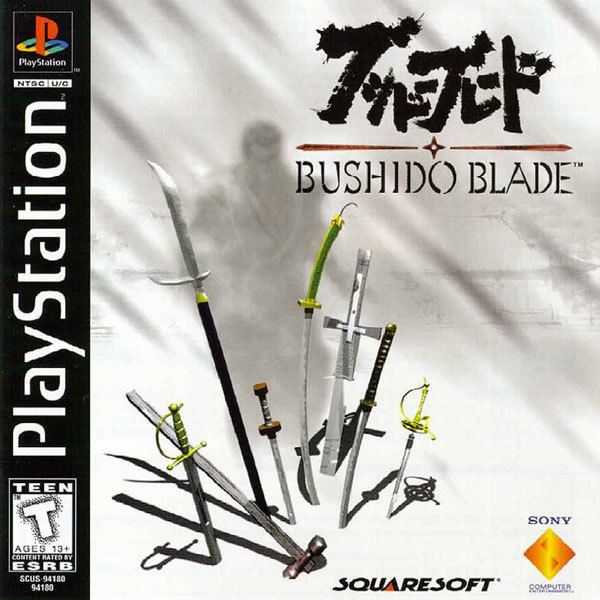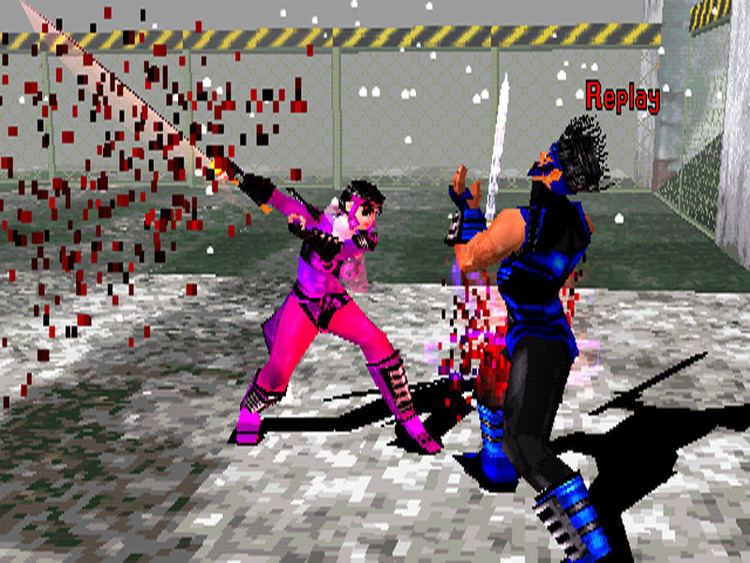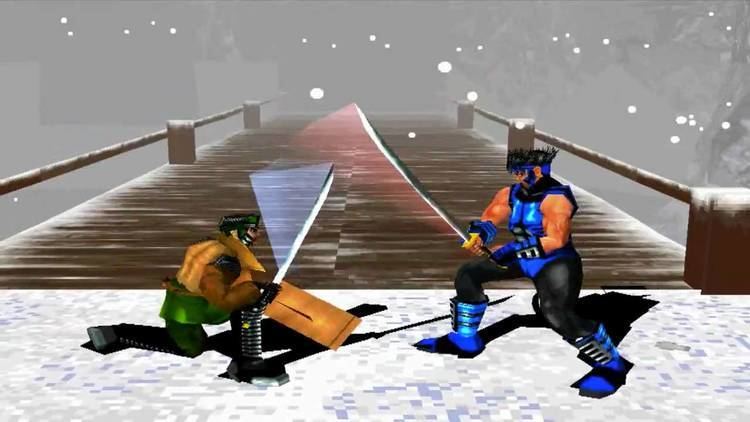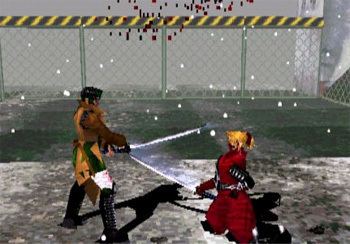Producer(s) Tetsuo Mizuno Initial release date 14 March 1997 Designer Bergsala Lightweight | ||
 | ||
Release date(s) PlayStationJP: March 14, 1997NA: September 30, 1997PAL: February 1, 1998Re-releasesJP: January 25, 2007(Legendary Hits re-release)JP: November 26, 2008re-release) Mode(s) Single-player, multiplayer Developers Square, Bergsala Lightweight Similar Square games, Fighting games | ||
Bushido Blade (ブシドーブレード, Bushidō Burēdo) is a 3D fighting video game developed by Light Weight and published by Square and Sony for the PlayStation. The game features one-on-one armed combat. Its name refers to the Japanese warrior code of honor, Bushidō.
Contents

Upon its release, the realistic fighting engine in Bushido Blade was seen as innovative, particularly the game's unique Body Damage System. A direct sequel, Bushido Blade 2, was released on the PlayStation a year later. Another game with a related title and gameplay, Kengo: Master of Bushido, was also developed by Light Weight for the PlayStation 2.

Gameplay

The bulk of the gameplay in Bushido Blade revolves around one-on-one third-person battles between two opponents. Unlike most fighting games, however, no time limit or health gauge is present during combat. Most hits will cause instant death, while traditional fighting games require many hits to deplete an opponent's health gauge. It is possible to wound an opponent without killing them. With the game's "Body Damage System," opponents are able to physically disable each other in increments with hits from an equipped weapon, slowing their attacking and running speed, or crippling their legs forcing them to crawl. Notably, the North American release of Bushido Blade had one minor graphical change: blood was added, replacing the yellow flash that appears during a fatal blow.

The game features eight weapons to choose from in many of its modes, including katana, nodachi, long sword, saber, broadsword, naginata, rapier, and sledgehammer. Each weapon has a realistic weight and length, giving each one fixed power, speed, and an ability to block. A variety of attack combinations can be executed by the player using button sequences with the game's "Motion Shift System," where one swing of a weapon is followed through with another. Many of these attacks are only available in one of three stances, switched using the shoulder buttons or axis controls depending on controller layout: high, neutral, and low. The player also has a choice of one out of six playable characters. Similar to the weapons, each one has a different level of strength and speed, and a number of unique special attacks. Some characters have a subweapon that can be thrown as well. All the characters have differing levels of proficiency with the selectable weapons and have a single preferred weapon.
Characters in Bushido Blade also have the ability to run, jump, and climb within the 3D environments. Because battles are not limited to small arenas, the player is encouraged to freely explore during battle. The castle compound which most of the game takes place in acts as a large hub area of interconnected smaller areas including a cherry blossom grove, a moat, and a bridge labyrinth. Some areas, such as the bamboo thicket, allow some interaction.
The story mode of Bushido Blade adds another gameplay mechanic: the Bushido code. Certain moves and tactics are considered dishonorable, such as striking a foe in the back, throwing dust in their eyes, or attacking while they bow at the start of fights. Acting dishonorably will abruptly end the player's playthrough after a certain point in the story, displaying a message berating them on their behavior.
In addition to the game's single player story mode, Bushido Blade contains a two-player versus mode and a link mode that supports the PlayStation Link Cable. Other single player options include a practice mode and a first person mode. Slash mode pits the player's katana-wielding character against a long string of 100 enemies, one after the other.
Plot
Despite characters, themes and weapons similar to samurai cinema set in Feudal Japan Bushido Blade takes place during the modern era (this is shown, for example, when the player reaches the helicopter landing pad phase set in a large city).
A fictional, 500-year-old dojo known as Meikyokan lies within this region, and teaches the disciplines of the master Narukagami Shinto. A society of assassins known as Kage ("Shadow") also resides within the dojo. Once led by the honorable swordsman Utsusemi, he lost his position to Hanzaki, another skilled member of the dojo, in a fierce battle. Hanzaki gained respect as the Kage leader, until he discovered a cursed sword known as Yugiri. He began to change, disregarding the group's honor and the traditions held by its students.
One day, a Kage member escapes the confines of the dojo with its secrets. Several other members of the society, under penalty of death, are sent to dispatch the defector, only catching up to him (or her) within the ruins of the surrounding Yin and Yang Labyrinth Castle. In single player mode the players take on the role of the escaped assassin (independent of whatever character they choose), fighting their way out by killing their comrades one by one. Elements of the game story differ with each character selected.
Characters
Playable characters:
Non-playable characters:
Audio
The score for Bushido Blade was created by Namco and Arika composer Shinji Hosoe with contributions by Ayako Saso and Takayuki Aihara. It was released with the soundtrack for Square's Driving Emotion Type-S, also composed by the trio, on a two-disc set in 2001. Unlike many other Square soundtracks of the era which were released by DigiCube, the music, copyrighted by Hosoe, was published by his own Super Sweep Records company. The Bushido Blade disc contains 23 tracks.
Much of the music utilizes the flute and violin, as well as a traditional Japanese instrument, the shamisen. Bushido Blade also uses voice acting from voice actors such as Chikao Ōtsuka, Makio Inoue, and Hidekatsu Shibata.
Release and reception
Bushido Blade was presold in convenience stores in Japan prior to its release, similar to Square's decision to presell its hit Final Fantasy VII in Lawson stores. Bushido Blade was the 25th best selling game of 1997 in Japan, selling nearly 388,000 copies. In November 2000, Bushido Blade was voted by the readers of Weekly Famitsu magazine as number 85 in its top 100 PlayStation games of all time. The game was later reprinted, along with a handful of other Square Enix titles, under the developer's "Legendary Hits" label. The game was also added to the PSone Classics roster on the Japanese PlayStation Store in 2008.
Bushido Blade was critically well received in North America. IGN rated the game an 8.7 out of 10. The review stated "I can't recommend Bushido Blade enough. Simply amazing." The gameplay mechanics were considered foreign by some, and required some practice. GameSpot similarly rated the game well with an 8.9 out of 10 rating, stating "Bushido Blade is a bold undertaking, but a remarkably successful one."
In 2006, the game was ranked number 190 on 1UP.com's list of The Greatest 200 Videogames of Their Time. In 2010, GamesRadar included Bushido Blade on the list of the seven "'90s games that need HD remakes".
